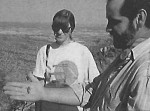Two joint U.S-Mexico research projects focusing on long-term ecological studies, either about to be launched or in the proposal evaluation stage, present important steps on the road toward extending LTER Network research to sites in Mexico.
As noted in the last issue of Network News, an NSF-supported U.S.- Mexico workshop to promote joint research in ecology was held in October 1994 at the Mapimí Biosphere Reserve Research Station in central Mexico.
Participants discussed potential common research interests in ecological responses to climate dynamics and land-use changes along the environmental gradient of the Chihuahuan Desert, stretching southward from central New Mexico to central Mexico (including the Jornada and Sevilleta LTER sites). The U.S. group was led by Jim Gosz, then-director of NSF’s Division of Environmental Biology (DEB), the Mexican group by Carlos Montana, Instituto de Ecología, Xalapa, Veracruz. The Mapimí Biosphere Reserve is managed by the Instituto and spans contiguous areas of the states of Durango, Coahuila and Chihuahua.
In June 1995, Sevilleta’s David Lightfoot and co-PIs James Brown and James Brunt submitted a collaborative proposal to DEB’s Long-Term Studies Program for a cross- site study of the effects of indigenous small mammals on the species composition and structure of plant communities in grassland and shrubland ecosystems within the Chihuahuan Desert. Jorge Lopez-Portillo submitted a parallel proposal to CONACyT (NSF’s counterpart in Mexico) under the bilateral agreement between NSF and CONACyT. The project has been recommended for a three- year award to the University of New Mexico, and is expected to begin in October 1995.
Lightfoot and his co-investigators aim to determine experimentally how small mammals affect Chibuahuan Desert ecosystems, and how these influences are, in turn, affected by short-and long-term climate change, both locally and regionally across the Desert. This project will extend to the Mapimí site research now under way at the Sevilleta and Jornada sites, and will provide a training opportunity for both U.S. and Mexican students. Significantly, the NSF grant will enable a real-time satellite communications link to be established at Mapimí, thereby connecting the site to LTERnet and allowing centralized integration of data management for the project.
Another collaborative project with Mexico, submitted to NSF’s International Programs in May and still pending, proposes a joint workshop on international ecology and biodiversity. The U.S. organizer and co-organizer is Gerardo Ceballos of the Centro de Ecología at the Universidad Nacional Autónoma de Mexico. The workshop would bring U.S. and Mexican ecologists from a variety of sub-fields and institutions together for meetings at Puerto Vallarta, Mexico and the Sevilleta.
Emily B. Rudin, program manager for the Americas at the NSF, is on assignment at the University of New Mexico, where she is special projects officer for research administration and visiting scholar at the Latin American Institute. For more information: rudin@sevilleta.unm.edu

 Enlarge this image
Enlarge this image